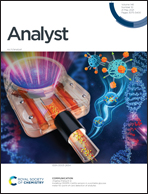MCR-ALS with sample insertion constraint to enhance the sensitivity of surface-enhanced Raman scattering detection†
Abstract
The multivariate curve resolution-alternative least squares (MCR-ALS) algorithm was modified with sample insertion constraint to deconvolute the overlapping peaks in SERS spectra. The developed method was evaluated by the spectral data simulated using a Gaussian distribution function to generate two independent peaks corresponding to a capping agent and an analyte. The spectra were generated with different overlapping levels and various intensity ratios of the analyte to the capping agent. By using MCR-ALS with the sample insertion constraint, the peak of the capping agent was completely excluded to obtain a calibration model of the analyte with R2 > 0.95 under all conditions. Furthermore, our developed method was later applied to a real SERS measurement to quantify carbofuran (analyte) using the azo-coupling reaction with p-ATP (capping agent) on silver nanoparticles as a SERS substrate. A calibration model of derivative carbofuran phenol was generated with R2 = 0.99 and LOD = 28.19 ppm. To assess the performance of the calibration model, the model was used to estimate the concentration of carbofuran in an external validation set. It was found that the RMSE of prediction was only 2.109 with a promising R2 = 0.97.



 Please wait while we load your content...
Please wait while we load your content...